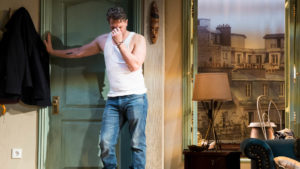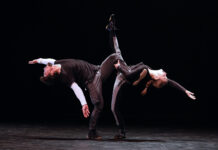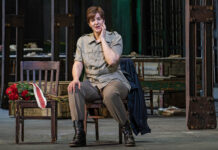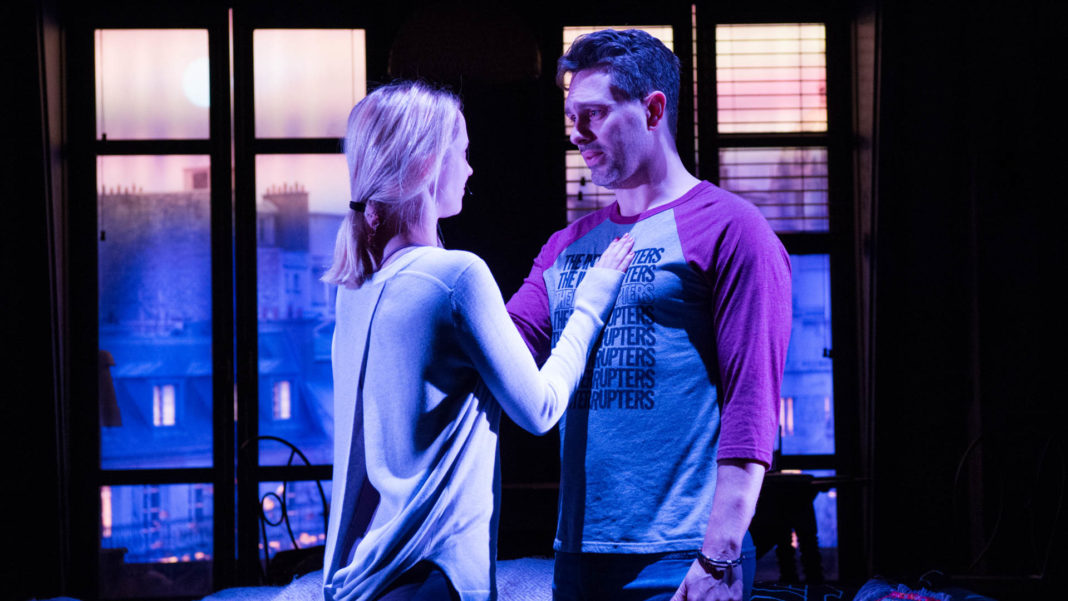
“I want the character you know at the end of the play to be different than who you met at the beginning,” says actor Thomas Sadoski of his goal, not just for Belleville in which he is currently appearing at the Pasadena Playhouse, but for all roles he tackles on stage. “Art is about growth and challenge. That’s what people come to see. They come to see humans challenged and grow and change and develop, not necessarily for the best.”
I spoke with Sadoski by phone during rehearsals for Belleville. The show officially opened on April 22nd and will continue through May 13th. In Amy Herzog’s play, Zack (Sadoski) and Abby (Anna Camp) are an American couple living in the Belleville section of Paris. He has a job in medicine and she’s been battling some personal demons and trying to find her way. The only other people shown are their Senegalese neighbors Alioune (Moe Jeudy-Lamour) and Amina (Sharon Pierre-Louis.) Over the course of the play we see the dynamics in Zack and Abby’s relationship change based on the truth each is willing to own.
Sadoski, who appears in the television series Life in Pieces, has long been an admirer of playwright Amy Herzog (4000 Miles and Mary Jane). “I am a huge fan,” he says enthusiastically. “To even get to play with her work at all is thrilling to me. I think it’s just an exquisite play. It’s the theatre of humanity in the best way in that you are constantly switching alliances through the course of the play and constantly being asked to question the accuracy and integrity of the narrator you are listening to. I find that to be incredibly human and the most powerful art in our medium. That art that makes you question what the hell is going on and you start to recognize yourself in everybody.”

The alternating alliances mean that giving away too much of the play would be a disservice to the audience. But Sadoski is willing to talk about the different facets of Zack that get peeled away over the course of the play. “You don’t want to drop too many layers too soon. You don’t want to hold onto them to the end and dump them all simultaneously because that can be overwhelming and you lose the audience. But if you are doing it slowly and over the course of 90 minutes, it doesn’t give the audience any place to hide. You force them on the journey with you. It’s an intricate surgical process in terms of building a foundation of the character, an emotional life between two characters and then finding out where the cracks in the walls start to show.”
Before a production of Belleville that was done by Steppenwolf in Chicago, Herzog said in an interview about the play, “in all relationships there are lies that are allowed to exist.” I asked Sadoski if he agreed and, if so, did he think those lies were borne out of fear or an attempt to keep the relationship going.

“What’s the difference? If you are attempting to keep a relationship working by lying then you are doing it because you are terrified of the relationship going away. I think fear is the driving force. In terms of these two characters, Zack and Amy, it is the gasoline and the engine that drives that relationship. One of the beautiful things is you are given a counterpoint relationship of pure trust and that’s the relationship between Alioune and Amina. It is the story of two relationships, one that is profoundly broken and another that is based in kindness and honesty and trust.”
Amongst Sadoski’s theatre credits are Jon Robin Baitz’s Other Desert Cities, John Guare’s The House of Blue Leaves and reasons to be pretty by Neil LaBute. The latter playwright has found himself amongst those whose actions in the #MeToo era have been called into question. In fact, MCC Theatre, an important off-Broadway theatre, severed ties with LaBute. Rather than discuss whether or not the allegations are true, I asked Sadoski if it is important to be able to separate the artist from the art.

“That’s a really interesting question and it seems to be the question of the day. I’m able to separate art from the artist to a certain extent. If I come across an artist who is portraying abuse or portraying some sort of incredible hateful act, a painful act, in their art and engaging in it in real life, it becomes a little bit of a no-go for me. But I’m also willing to acknowledge that imperfect people can create tremendous things and that being able to appreciate Wagner or Picasso or the songs or poems of somebody whose beliefs or actions you might find distasteful, it all comes down to the Walt Whitman of it all. We all ‘contain multitudes.’ We have to see beyond black and white. My concern as an artist is if we only see black and white, then art is dead. There is no point in continuing. The whole point is to hold up man’s imperfections in front of each other and say ‘this is the experience, may we all learn. May we all experience through each other’s eyes and ears and hearts and souls.’ On some level that evaporates when you miss the piece for the maker.”
All photos by: Philicia Endelman











